Chilli Beads
So what are Chilli Beads? The sho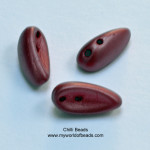 rt answer is, a shaped two-holed seed bead. Designed to look a little like Chilli beans, as you are about to find out, these beads are interesting, distinctive and give you the ability to add fabulous texture, shape and pattern to your seed bead designs. Read on to find out more about the size and shape of Chilli beads, design ideas for working with them and, last but not least, some links to patterns using Chilli beads.
rt answer is, a shaped two-holed seed bead. Designed to look a little like Chilli beans, as you are about to find out, these beads are interesting, distinctive and give you the ability to add fabulous texture, shape and pattern to your seed bead designs. Read on to find out more about the size and shape of Chilli beads, design ideas for working with them and, last but not least, some links to patterns using Chilli beads.
A Brief Introduction to Chilli Beads
Take a close look at the photo above and you can see the Chilli beads have a very distinctive shape. Almost a teardrop, they are indented on one side and rounded on the other. As soon as I first saw them, I immediately thought of flower petals. These beads come in a huge range of colours, so you can straightaway find something to add to your design work on all levels. They measure about 11mm x 4mm and have a smooth finished surface that is very appealing in visual terms. Perhaps most importantly, Chilli beads are a variety of two-holed bead. You can see the holes both sit near the bottom of the bead. Their design also means they will ‘snuggle’ inside one another.
Tips for Working with Chilli Beads
Firstly, as with all two-holed beads, remember to check both holes before you use each bead. I have not found many blocked holes with these beads, but it only takes one and you may find yourself having to undo a lot of beadwork, so take the time to check both holes are clear before you add each bead.
Secondly, bear in mind that the distinctive shape of these beads makes it imperative that you pick them up correctly. Take note of the pattern instructions, diagrams and photos that accompany your patterns so you make sure that you enter the bead from the right direction – either indented front or rounded back. I found it is very easy to pass through them from the wrong side, so take care as you work.
Thirdly, take care that you are passing through the correct hole as you work. When you have a choice of two holes, it can be very easy for your needle to accidentally slip through the wrong hole, especially if you are working in a slightly tight spot. So make sure you work in good light and check your thread paths carefully as you go.
Designing with Chilli Beads
The thoughts I am about to share may sound familiar. If you are used to working with traditional one-holed little seed beads, whether they are rocailles or cylinder beads, then you may be used to being able to draw, plan and design before you take up the beads. I have repeatedly found that the shaped multi-holed beads require to be actually worked with. Their shape and the placement of their holes means that they do not always behave in the way that you might expect.
I tried some si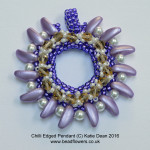 mple edging and found that the way in which the Chilli beads sit has the potential to create some interesting dilemmas. One of the designs I am unable to share with you yet, so do check back here to see this when it is revealed. I can however share this simple pendant that uses the beads for a basic edging, just to add a simple interest to the design.
mple edging and found that the way in which the Chilli beads sit has the potential to create some interesting dilemmas. One of the designs I am unable to share with you yet, so do check back here to see this when it is revealed. I can however share this simple pendant that uses the beads for a basic edging, just to add a simple interest to the design.
I also mentioned that my immediate reaction to the beads was to think of flowers, so I worked on a few ideas for linking them into circles to create petals. I fo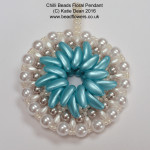 und that the structure of the holes led to some unexpected results. If you wish to use both holes, then you are not left with a great deal of ‘petal’ extending from the flower. It is of course possible to use just one hole and leave the second one un-linked, but the beads are less stable in the way they link in this instance. So I had some fun using the structure to create layered effects. You can find links to two floral patterns below so you can see what I mean. My first attempt, the floral pendant is photographed here.
und that the structure of the holes led to some unexpected results. If you wish to use both holes, then you are not left with a great deal of ‘petal’ extending from the flower. It is of course possible to use just one hole and leave the second one un-linked, but the beads are less stable in the way they link in this instance. So I had some fun using the structure to create layered effects. You can find links to two floral patterns below so you can see what I mean. My first attempt, the floral pendant is photographed here.
I also wanted to move beyond circles, so I began to think about how Chilli beads could be used in traditional beading techniques. As with the other experiments, I soon discovered some unexpected results. The Cubic Right Angle Weave. This allowed me to experiment with the shaping and texture of the beads as I came up with my Waterlily design….scroll down for the pattern.
other experiments, I soon discovered some unexpected results. The Cubic Right Angle Weave. This allowed me to experiment with the shaping and texture of the beads as I came up with my Waterlily design….scroll down for the pattern.
The debate with any new shaped bead is always how long it is going to stay around. My ‘play-time’ so far has led me to the conclusion that Chilli beads are as versatile as they are attractive. So, with all this design potential, combined with the beautiful range of colours, I would like to think that these beads are here to stay.
Patterns for Chilli Beads
As you will have been reading, Chilli beads have great design potential and I confess I’m finding them quite addictive to work with, so you can expect more patterns to pop up here. For now, if you like the look of the floral pendant, you can find the pattern for that here. The Textured Bracelet, showcasing my first experiments with Peyote stitch and Chilli beads, is available here.
I have also created another necklace design. This combines seed beads, Superduos and Dome beads with the Chilli beads, using traditional Peyote stitch techniques to link the flowers. I designed a rope using a combination of CRAW and tubular Peyote, with a beaded clasp to complete the necklace. However, any beaded rope will work with the front focal section, so if you feel as though your beading skills aren’t yet up to the CRAW, you can create something that suits you better. The pattern for this necklace is available here.
Speaking of CRAW, I mentioned ab ove that the CRAW idea had led me to my Waterlily design. Well, don’t worry – the thread path is not nearly as complex as that description of the design might lead you to fear. The two-holed structure allowed me to play with different levels and dimensions very easily, adding an embellishment and a clever snap fastener clasp at the end. This is in fact a simple project to try, so not a bad place to start. You can find the pattern here.
ove that the CRAW idea had led me to my Waterlily design. Well, don’t worry – the thread path is not nearly as complex as that description of the design might lead you to fear. The two-holed structure allowed me to play with different levels and dimensions very easily, adding an embellishment and a clever snap fastener clasp at the end. This is in fact a simple project to try, so not a bad place to start. You can find the pattern here.



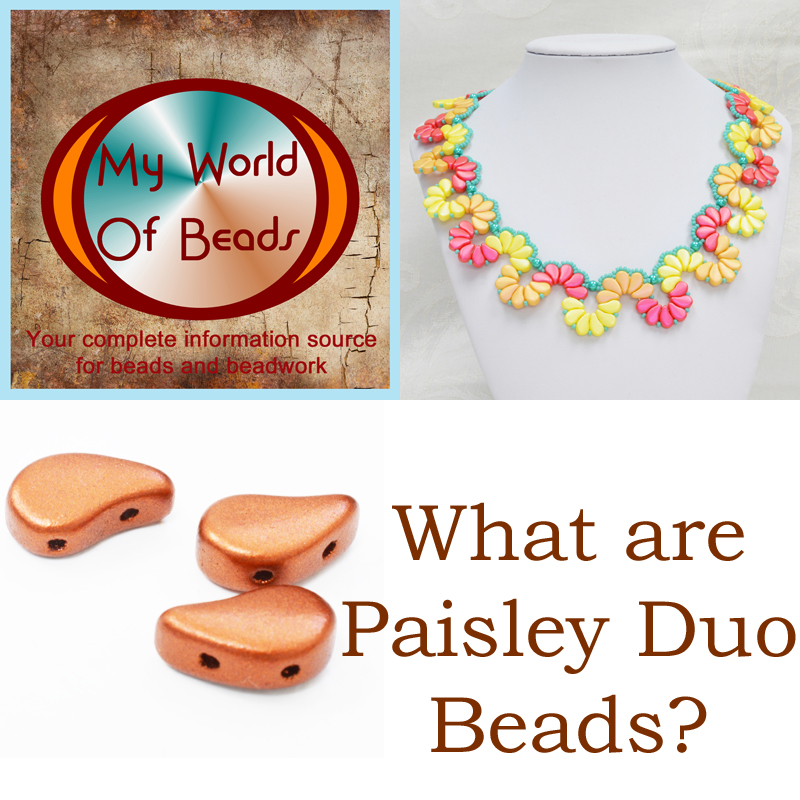
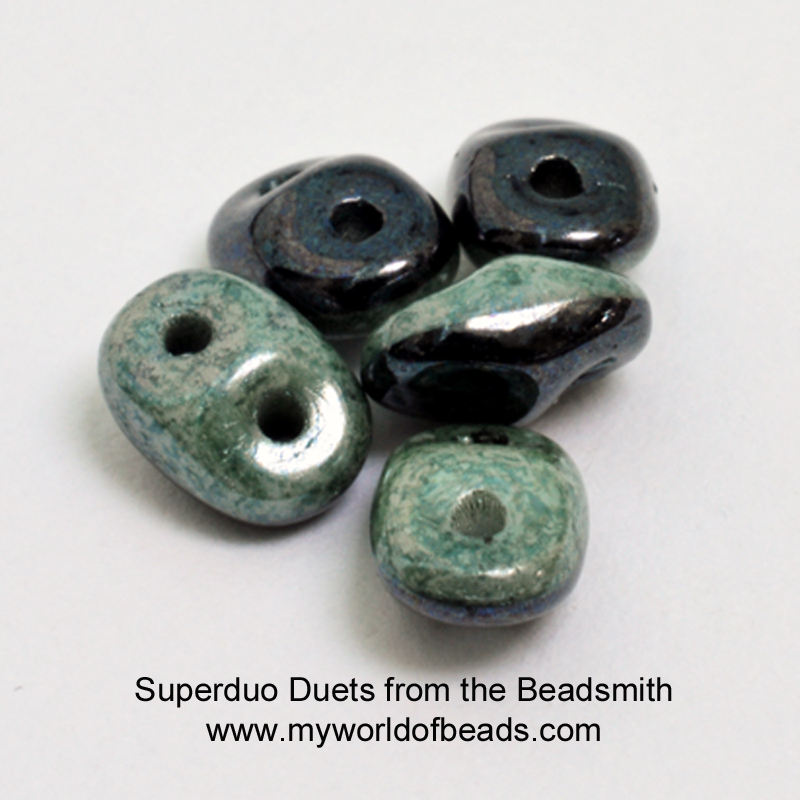







nice information. thanks.
It’s a pleasure – thank you!